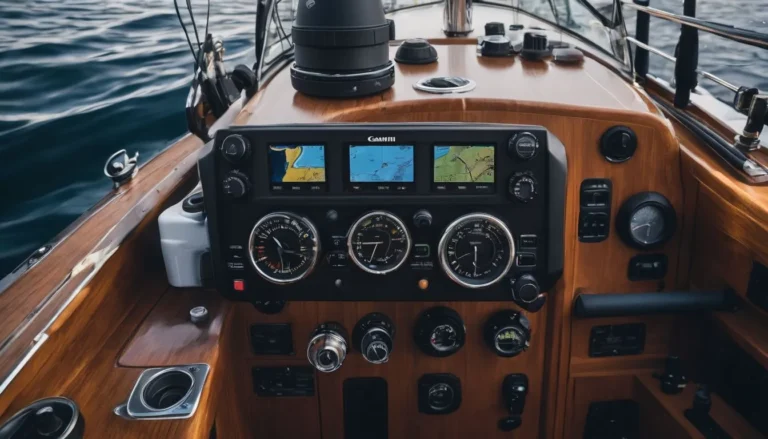What Are the Blue and Brown Wires for on a Garmin Depth Finder?
Setting up your Garmin depth finder should be smooth sailing, but the maze of wires can often lead to confusion.
One crucial detail is knowing what the blue and brown wires are for.
This blog post will clear the fog around these cables, guiding you through their functions and how they power your nautical adventures.
Dive into our guide for a trouble-free setup!
Key Takeaways
- The blue wire on a Garmin depth finder supplies positive power from your boat to the device, turning it on and ensuring it works correctly.
- It’s crucial to connect the brown wire properly because this acts as the negative power supply or ground wire, completing the electrical circuit in your device.
- Securely connecting both blue and brown wires using marine – grade connectors prevents corrosion and guarantees that the depth finder receives a stable power flow for accurate readings.
- If your Garmin depth finder doesn’t turn on, check both wires for damage or loose connections, ensure proper fuse placement, and try resetting the device if necessary.
- Proper wiring of these cables not only helps in reliable operation but also plays a part in protecting your investment by preventing potential damage to the depth finder.
Purpose of Blue and Brown Wires on a Garmin Depth Finder
The blue and brown wires in a Garmin depth finder serve distinct roles that are essential for device functionality and interconnectivity. Understanding their purpose is key to ensuring the proper setup and performance of your marine electronics.
Blue Wire Functionality
In your Garmin depth finder, the blue wire plays a critical role as it supplies positive power from your vessel’s system to the device. This essential connection is what brings your depth finder to life, allowing you to benefit from its advanced aquatic insights.
Hooking up this wire correctly ensures that not only does your device turn on, but it also performs optimally, providing accurate readings of what lies beneath the water’s surface.
Connecting the blue wire improperly could lead to frustrating outcomes like false readings or even complete system failure. It’s one half of a crucial duo—alongside the negative ground wire in the wiring harness—that powers up your technology for successful navigation and fish-finding adventures.
Make sure this vital link between power source and depth finder is secure, and you’ll be set for smooth sailing with reliable data at your fingertips.
Brown Wire Functionality
Moving on from the blue wire, which handles data communication, let’s talk about the brown wire. This essential component is responsible for providing a negative power supply to your Garmin depth finder.
It’s critical to connect the brown wire properly because it completes the electrical circuit within your device. A secure and accurate connection ensures that your depth finder receives a stable power flow.
Care must be taken during installation, as hooking up the brown wire incorrectly can lead to serious problems. Not only could you damage your depth finder, but mishandling this crucial part of the power and data cable might also void any warranty on your device.
Remember, this isn’t just any other wire; it’s vital for powering up and safeguarding your investment in nautical technology. Always double-check connections with NMEA 0183 devices to ensure safety and functionality down to every single plug and connector in the system.
Connection of Blue and Brown Wires in a Garmin Depth Finder
Connecting the blue and brown wires correctly is vital for your Garmin depth finder to work properly. These wires ensure that the device receives the right amount of power from your boat’s electrical system. Here’s how to make sure you get it right:
- Identify the blue wire, which serves as the positive power supply line. This wire should connect directly to the positive terminal of your boat’s power source.
- Locate the brown wire, designated as the negative power supply or ground wire. Connect this wire to a clean, metal part of the boat’s frame for grounding or directly to the battery’s negative terminal.
- Use marine – grade connectors to secure both wires firmly. These specialized connectors prevent corrosion and ensure longevity in a damp environment.
- Keep wires away from areas that can damage them, like moving parts or sharp edges, avoiding unnecessary wear.
- Wrap all wired connections with electrical tape for extra protection against moisture and to ensure a longer-lasting setup.
- Check your Garmin depth finder manual for any specific instructions regarding fuse requirements. Fuse placement is crucial to protecting your equipment against surges and electrical shorts.
- Test your connection by turning on the Garmin depth finder without starting the engine to see if it powers up successfully.
Troubleshooting: How to Turn on Your Garmin Depth Finder
Turning on your Garmin depth finder should be a straightforward process, but sometimes things don’t go as planned. If you’re having trouble getting your device to power up, follow these steps to diagnose and fix the issue.
- Check the main power supply for any signs of damage or loose connections. Ensure that it’s delivering power as intended.
- Examine the blue wire, which serves as the positive power supply wire, for secure connection points and potential breaks or frays.
- Inspect the brown wire, which functions as the negative power supply wire. Look for corrosion or disconnections that could interrupt the circuit.
- Confirm that the fuse in the power cable is not blown. Replace it with an appropriate new one if necessary.
- Verify that all other connected devices are functioning properly. A faulty linked device may prevent your depth finder from powering on.
- Reset your Garmin depth finder by holding down its power button for a few seconds. Sometimes a simple reset can resolve underlying software issues.
- Make sure there isn’t an overload on your boat’s electrical system. Too many devices drawing power at once can cause individual items to receive insufficient voltage.
- Consult your Garmin depth finder manual for specific troubleshooting guidelines tailored to your model.
Conclusion
Understanding the functionality of the blue and brown wires in your Garmin depth finder is crucial for optimal performance. Always connect the positive blue wire to the power source’s positive terminal, and pair the negative brown wire with the negative terminal.
Remember, proper installation paves the way for seamless navigation and fishing experiences. Rest assured that knowing how to handle these connections equips you with valuable knowledge for maintaining your device’s longevity.
Engage confidently with your depth finder, secure in the knowledge that you’ve got wiring down to a science.
If you encounter any issues powering up your device, be sure to check out our step-by-step guide on how to turn on your Garmin depth finder.
FAQs on Blue and Brown Wires for on a Garmin Depth Finder
Gary Burrell
Born in 1989, Gary Burrell is an Electrical Engineering graduate from the University of Tennessee. With 20+ years of experience, he has transitioned from engineering roles to becoming the Chief Content Editor. Gary’s unique blend of technical knowledge and editorial expertise has made him an essential figure in content creation, ensuring clarity and accuracy. His journey from an engineer to an editor showcases his adaptability and commitment to continuous learning.




